You'll need to follow updated standards like IEC 61000-4-2 and ISO 10605 for ESD environment testing in 2025. Maintain your testing area at 23°C ± 3°C with relative humidity between 30-60%. You must perform both air and contact discharge methods while using properly calibrated surface resistance meters and ESD testing simulators. Your personnel need thorough training and certification following IEC 61340-5-1 guidelines, and you'll need to keep detailed documentation of all tests and results. The latest protocols include enhanced requirements for test methodologies and climate conditions that'll greatly impact your compliance strategy.
Updated ESD Testing Standards
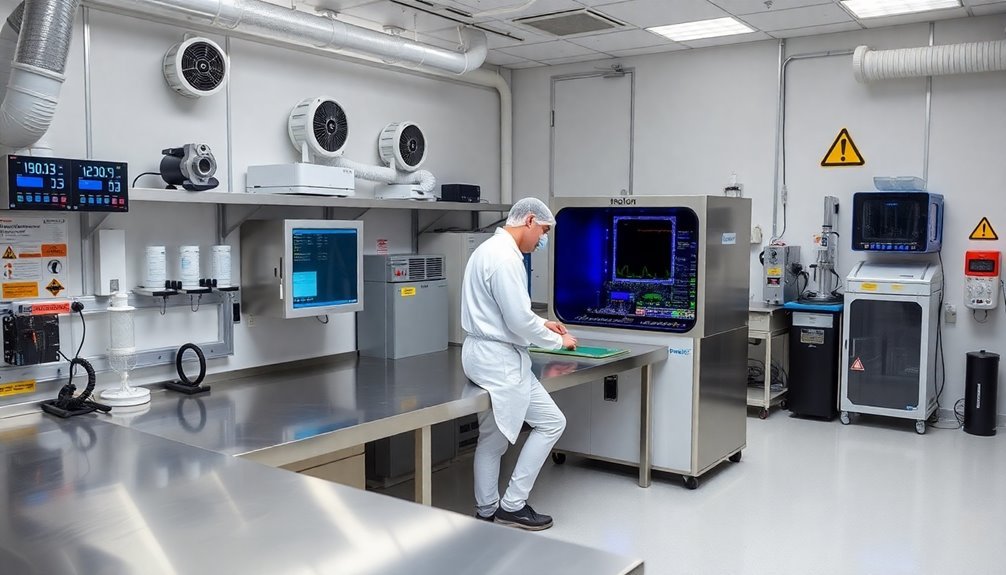
In accordance with the latest industry developments, the updated ESD testing standards for 2025 incorporate three primary protocols: IEC 61000-4-2, ISO 10605, and MIL-STD-461 CS118.
You'll need to understand these standards as they're essential for guaranteeing your products meet international requirements across consumer electronics, automotive, and aerospace industries.
The standards now emphasize more detailed test methodologies, including specific climate conditions you must maintain during testing. Test reliability heavily depends on maintaining relative humidity levels between 30-60%.
You'll find updated guidelines for both contact and air discharge methods, along with precise instructions for test setup configurations.
When you're conducting tests, you'll need to pay particular attention to the positioning of your ESD gun return cable and the selection of appropriate test points.
You should note that these standards are part of a broader classification system that includes Standard Test Methods, Standard Practices, and Technical Reports.
With the expected 2024/2025 revision of ANSI C63.16, you'll see additional updates reflecting new methodologies and industry requirements.
These revisions aim to reduce marketplace confusion and guarantee you're implementing effective ESD control programs that align with international consistency requirements.
Essential Monitoring Equipment Requirements
For flooring and work surfaces, you must use surface resistance meters to verify compliance with resistance standards.
Test all new surfaces before implementation and conduct regular retesting.
Keep detailed documentation of all surface testing results to maintain compliance with the updated 2025 standards.
Remember to position your ionization equipment for maximum coverage of work areas.
Use ESD testing simulators with voltage ranges to 30kV to validate your testing environment's safety measures.
Personnel Training and Certification
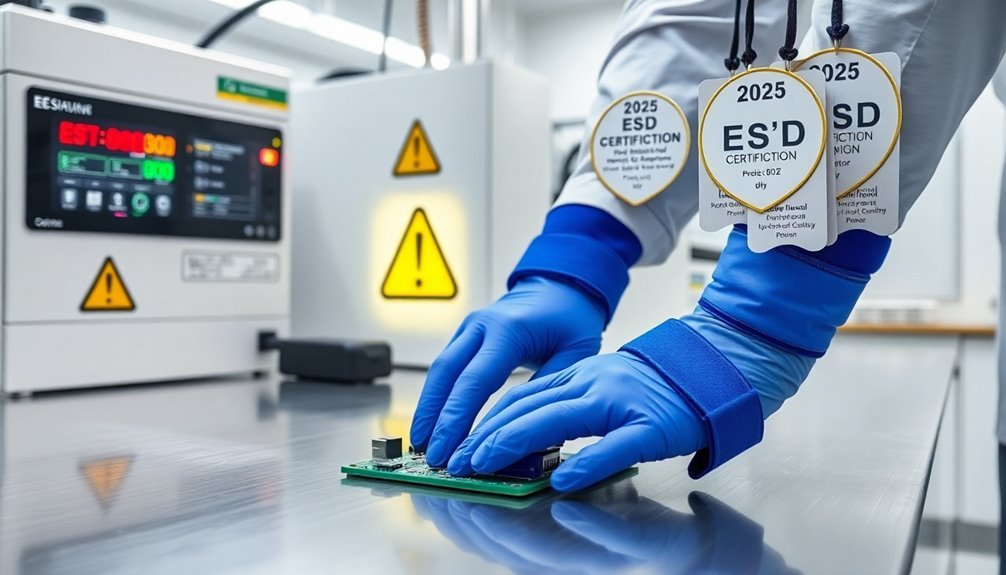
Your ESD certification requirements must include thorough training on both fundamental ESD principles and specific control procedures to meet the updated 2025 standards.
With low relative humidity environments posing increased ESD risks, personnel must be trained to take extra precautions during colder months and in climate-controlled facilities.
You'll need to implement a structured training program that combines hands-on demonstrations, interactive computer-based learning, and regular refresher courses to maintain certification compliance.
To verify your personnel's competency, you should integrate compliance auditing with documented observation of ESD control procedures and conduct regular performance measurements.
ESD Certification Requirements
Professionals seeking ESD certification must follow strict requirements established by the EOS/ESD Association, Inc. As of July 1, 2023, you'll need to comply with ANSI/ESD S20.20-2021 standards, while IEC 61340-5-1-2024 certifications remain valid until June 2025. After that, you must shift to the 2024 version exclusively.
You'll need to undergo annual audits of your ESD control programs through accredited certification bodies. These assessments typically take up to two days to complete for a thorough evaluation. These assessments evaluate your documentation, ESD control element selection, and training protocols. Your facility's certification is location-specific, so if you operate multiple sites, you'll need separate audits for each one.
Your training program must include both initial and recurring sessions covering ESD physics, specific procedures, and your role in maintaining ESD protection. You'll need to demonstrate effectiveness through practical application in ESD Protected Areas (EPAs).
The certification process also requires you to implement thorough compliance verification audits using test procedures outlined in TR53. These audits help you identify equipment changes and verify your program's ongoing effectiveness.
Training Program Best Practices
A well-structured ESD training program starts with thorough initial instruction and builds through ongoing education.
You'll need to implement extensive training that follows international standards like IEC 61340-5-1 and ANSI/ESD S20.20, guaranteeing all personnel understand ESD fundamentals and their specific role requirements.
You should utilize various training tools, including live instruction, interactive computer-based programs, and practical demonstrations. Training sessions are available at established training centers in Gernlinden and Lohmar.
It's important to maintain a centralized repository of educational materials and implement certification programs to validate employees' knowledge.
Consider using eLearning platforms like IPC EDGE for standardized training and certification.
You'll want to customize training modules for different roles within your organization, from assembly technicians to management.
Don't forget to include suppliers who handle ESD-sensitive items.
Regular compliance verification through audits and inspections is vital to verify your program's effectiveness.
When you identify non-compliance issues, address them promptly with appropriate measures, from retraining to disciplinary actions.
Remember to collect quality and reliability data to demonstrate program effectiveness and identify areas where you can improve your training methods and content.
ESD Protected Area Setup
Three critical elements form the foundation of an ESD Protected Area (EPA) setup: controlled environment, proper grounding, and protective equipment.
You'll need to maintain proper humidity and temperature levels while guaranteeing all equipment and personnel are connected to a common ground point to prevent static buildup.
To establish your EPA, you'll first need to assess which areas require protection for handling sensitive electronics.
Install conductive or static-dissipative flooring, and equip your workspace with ESD-safe materials and surfaces.
The size of your EPA can range from a single workstation to an entire manufacturing floor.
You must provide personnel with proper protective equipment, including wrist straps, ESD-safe clothing, and shoes.
Your EPA boundaries should be clearly marked with appropriate signage to remind workers of ESD safety protocols.
You'll need to remove or replace non-conductive materials with ESD-protective versions where possible.
For process-essential insulators that can't be eliminated, install ionizers to neutralize static charges.
Remember to implement regular testing and assessment of your EPA's effectiveness.
You'll want to verify that all grounding connections are functioning correctly and that your ionization systems are working as intended.
This systematic approach guarantees consistent protection against ESD damage.
Static Control Measurement Protocols
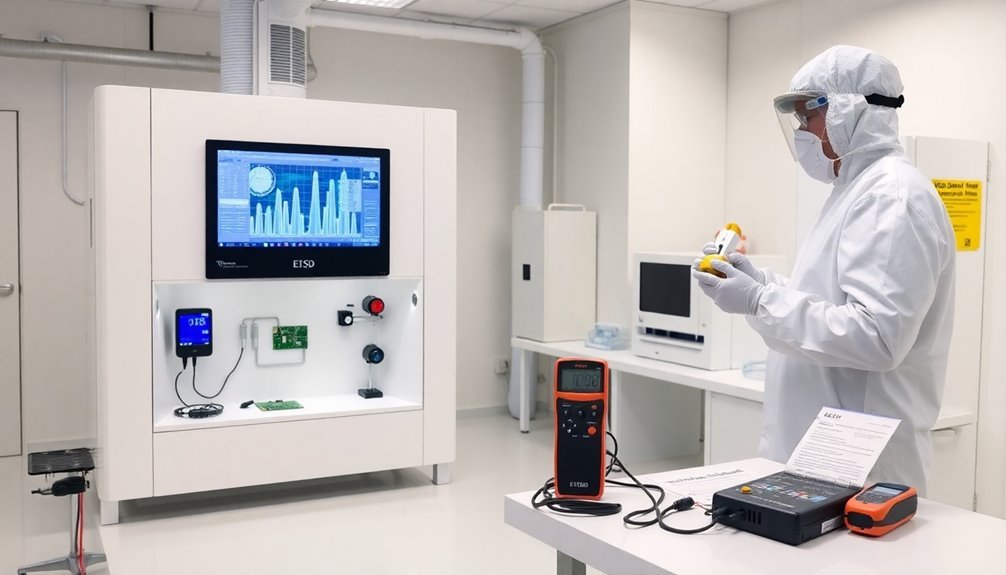
You'll need to update your testing equipment verification methods to align with the enhanced calibration standards coming in 2025, which now require verification at both 1 × 10^6 and 1 × 10^9 ohm thresholds.
Your measurement tools must undergo more frequent calibration checks, especially when testing materials in dynamic environments where static decay times are critical. Daily wrist strap testing is mandatory unless continuous monitoring systems are in place.
When verifying your equipment's accuracy, you'll need to document compliance with the consolidated ESD TR53 guidelines, which now incorporate stricter tolerances for measurement precision in fast-moving industrial processes.
Calibration Standards Evolution
While ESD control standards continue to evolve, the third edition of IEC 61000-4-2 stands as a pivotal development expected in April 2025. You'll need to stay current with these changes as the ESD Association actively updates and develops new standards for electrostatic control and testing procedures.
ANSI/ESD S20.20 serves as your foundation for ESD control implementation, referencing various standards that define specific control measures. The industry's increasing complexity with higher device circuitry density demands more rigorous testing protocols. You'll find that ongoing harmonization efforts are aligning requirements across different ESD standards to guarantee you're working with consistent, quality-focused guidelines.
You must pay attention to the enhanced reporting requirements and equipment calibration methods being integrated into these standards. The updates focus on improved verification methods and compliance procedures, making your ESD control program more effective.
When you're implementing these standards, you'll notice they're becoming more thorough, incorporating detailed specifications for everything from worksurface testing to air ionizer verification. The evolving standards also emphasize the importance of regular verification and testing schedules, guaranteeing your ESD protection measures remain reliable and up-to-date with industry requirements.
Testing Equipment Verification Methods
Testing equipment verification demands strict adherence to IEC 61000-4-2 protocols, particularly when evaluating ESD simulator performance. You'll need to verify tip voltage and current waveform characteristics using high-bandwidth oscilloscopes like Tektronix 4/5/6 Series MSOs. It is crucial to document these verification tests before proceeding with compliance testing.
| Verification Type | Required Actions | Key Standards |
|---|---|---|
| Visual Control | Check grounding of surfaces and operators | IEC 61340-5-1:2016 |
| Measurement | Use specialized equipment for performance verification | ANSI/ESD Standards |
| Documentation | Maintain checklist and testing schedule | ISO 10605 |
You'll need to follow specific measurement protocols when testing ESD control items. These include evaluating electrical system resistance of floor materials and testing personnel wearing static control garments. Don't forget to implement periodic verification schedules for all ESD control items. Your testing should incorporate high-impedance, high-voltage resistive voltage dividers for pre-compliance tests, and you must document current peaks at specific intervals (30ns and 60ns). Remember that ESDA continuously updates these standards through their working groups, so you'll need to stay current with the latest requirements.
Documentation and Record Keeping
A robust documentation system serves as the backbone of any effective ESD control program.
You'll need to maintain thorough records of all ESD-related activities, including test results, calibration verifications, and training sessions. Your documentation must be easily accessible for audits while guaranteeing sensitive information remains protected.
You'll want to implement strict version control measures to assure that only the latest documents are in use. Keep detailed audit records, including findings and corrective actions, and maintain trend charts to track the effectiveness of your ESD control measures.
Your training records should document both initial and ongoing personnel training activities.
For document revision control, you must establish a regular update schedule and guarantee all changes receive proper authorization. When you make updates, promptly distribute them to relevant parties and maintain a revision log.
You're responsible for storing these documents securely, with regular backups of electronic files and appropriate protection for physical documents. Set up an access control system to monitor who can view and modify ESD control documentation, and classify documents based on their sensitivity level.
Remember to keep compliance reports readily available for audit purposes.
Compliance Verification Methods
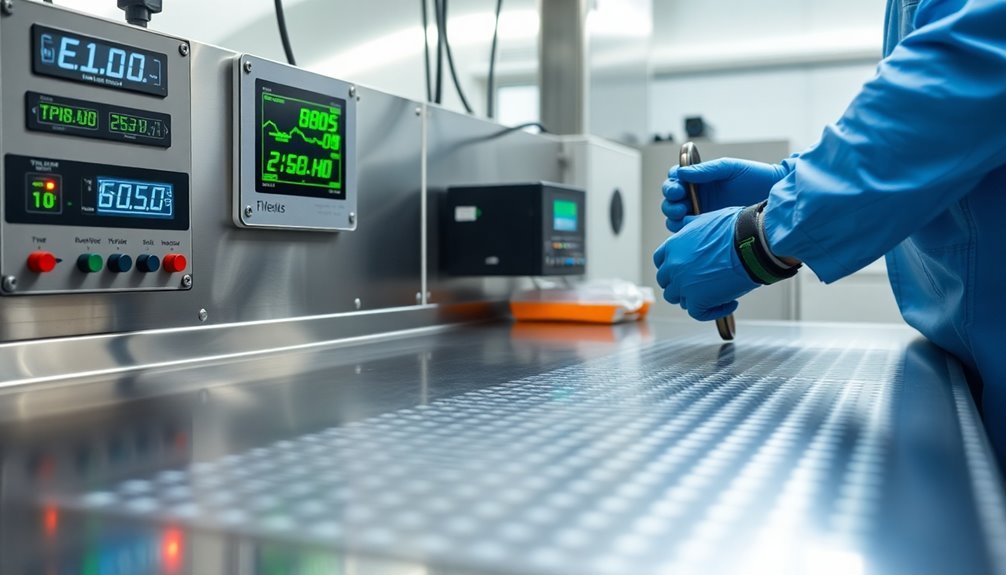
Through systematic verification methods, you'll need to implement thorough ESD compliance testing across your facility. Your testing program must include specialized equipment like static meters and continuous monitors to verify EPA compliance.
You'll need to follow sampling techniques and statistical analysis methods to guarantee accurate results. Regular monthly verification schedules are essential for checking wrist straps, floors, clothing, and worksurfaces.
You'll want to pay special attention to the integrity testing of personal grounding devices and equipment grounding systems. When conducting compliance verification audits, use detailed checklists and maintain consistency by having a single auditor perform the checks.
Your testing methods should align with ESD TR53 guidelines, which provide extensive test procedures and frequencies. If you identify any deficiencies during testing, you'll need to implement immediate corrective actions, such as retraining staff or revising processes.
Remember that the upcoming IEC 61000-4-2 standard update in April 2025 may introduce new testing requirements. You'll also need to incorporate ESD event detection methods and simulator testing to assess product immunity to ESD events.
ESD Events Risk Assessment
Effective risk assessment forms the cornerstone of your ESD control program. You'll need to follow ANSI/ESD SP17.1 methodologies to properly identify and evaluate potential ESD risks in your processes.
When conducting your assessment, you'll need to examine risks from charged personnel, ungrounded conductors, charged ESDS items, and electrostatic environments.
Your risk assessment process should focus on these critical areas:
- Critical contact points with ESD-sensitive items during handling and processing
- ESD event detection measurements in your specific environment
- Device classification using both Human Body Model and Charged Device Model standards
- Process capability evaluations for machine discharge and charged board events
- Assessment of your current ESD protective measures and their effectiveness
You'll need to pay special attention to handling class 0Z and 0A items, as they require enhanced protective measures.
Remember that there's no direct correlation between field discharges and test system results, so you must evaluate your actual working environment.
With ESD sensitivity thresholds projected to become more stringent through 2030, you'll need to continuously update your risk assessment protocols to maintain effective protection.
Environmental Control Parameters
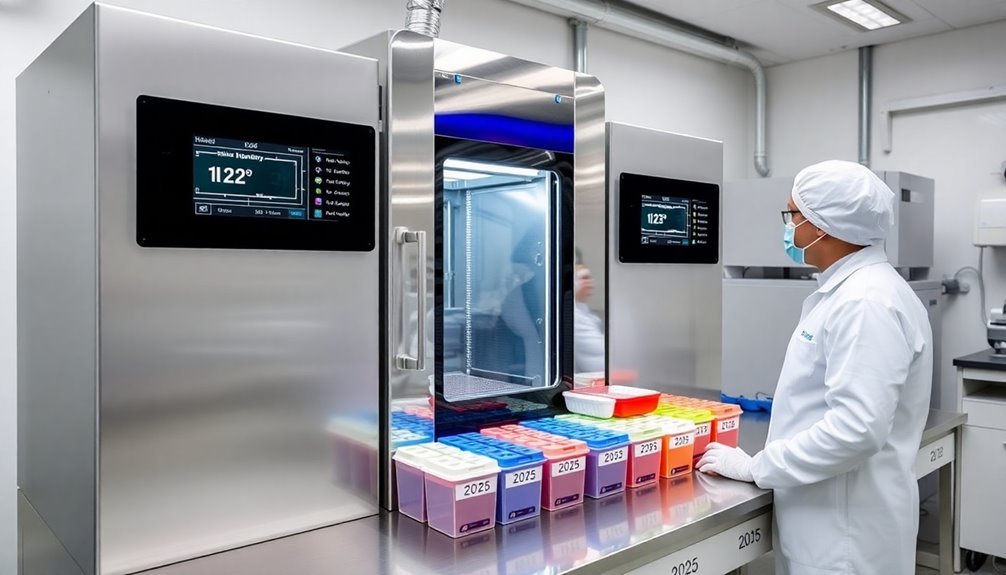
Building on your risk assessment findings, proper environmental control parameters create the foundation for reliable ESD testing and protection.
You'll need to maintain specific climate conditions, with testing temperatures at 23°C ± 3°C and relative humidity at 12% ± 3% for most critical scenarios. Both air and contact discharge methods must be incorporated to thoroughly evaluate your product's ESD immunity.
In your ESD Protected Areas (EPAs), you'll want to implement strict grounding requirements. Make certain all work surfaces are properly dissipative and that your personnel use ESD wrist straps when handling sensitive components.
You'll need to certify your EPAs based on your most sensitive device's requirements.
Your test equipment must follow IEC 61000-4-2 standards, using calibrated ESD simulators with verified standard current waveforms.
Don't forget to account for uncertainty parameters and monitor your bleed resistors for degradation. Keep up with the latest standards, including IEC 61000-4-2 and ANSI C63.16, as they're regularly updated.
You'll find consolidated compliance verification tests in ESD TR53, which will help guarantee consistency across your testing procedures.
Frequently Asked Questions
How Often Should ESD Flooring Be Replaced in High-Traffic Manufacturing Areas?
You'll need to replace your ESD flooring every 3-5 years in high-traffic manufacturing areas, but with proper daily maintenance and quarterly testing, you can extend its lifespan to maximize your investment.
What Temperature and Humidity Fluctuations Can Impact ESD Test Results?
You'll notice significant impacts on ESD test results when temperatures deviate from 23°C ± 3°C or humidity falls below 12%. Higher temperatures can decrease breakdown voltage, while lower humidity increases static discharge risk.
Can Wireless Devices Be Safely Used Within ESD Protected Areas?
No, you shouldn't use wireless devices in ESD protected areas. They don't meet ANSI/ESD S20.20 standards and can't prevent charge buildup. You must use continuously connected wrist straps to a common ground point.
Which ESD Control Measures Are Most Cost-Effective for Small Businesses?
You'll get the best value from using anti-static sprays, DIY grounding solutions, and basic employee training. Don't forget to implement conductive mats and wrist straps – they're affordable yet highly effective protection.
How Do Seasonal Changes Affect ESD Testing Requirements and Procedures?
You'll need to test ESD control items at your facility's lowest annual humidity levels. During seasonal changes, verify your equipment works properly at both standard conditions (12% RH) and your actual facility conditions.
In Summary
You'll need to stay current with the evolving 2025 ESD testing standards by maintaining proper documentation, ensuring your team's certifications are up-to-date, and regularly calibrating monitoring equipment. Don't forget to conduct periodic risk assessments and verify your ESD protected areas meet the latest requirements. Remember, consistent environmental control parameters and proper static control measurement protocols are essential for compliance.

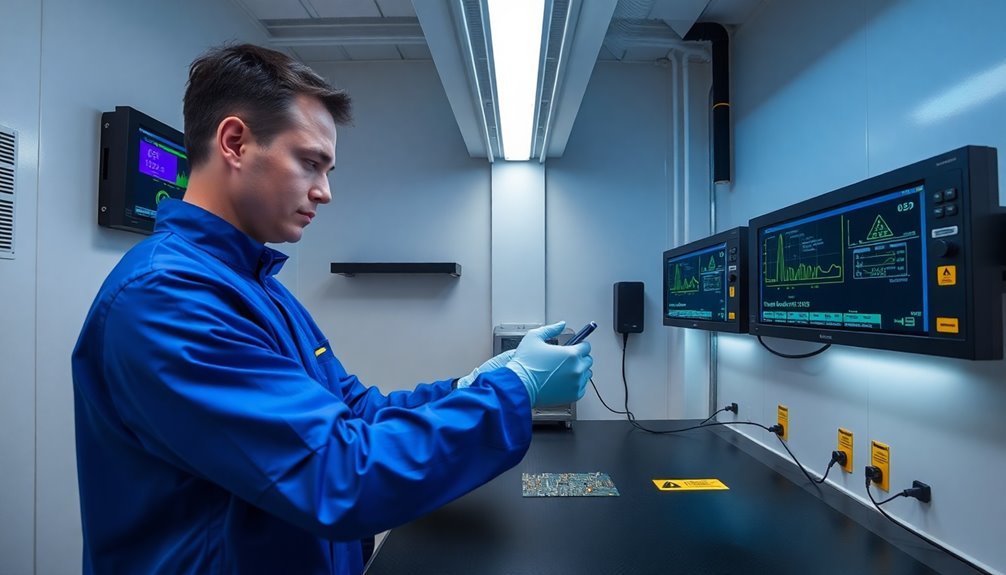



Leave a Reply